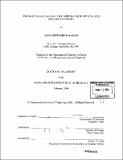| dc.contributor.advisor | Timothy M. Swager. | en_US |
| dc.contributor.author | Paraskos, Alexander John, 1969- | en_US |
| dc.contributor.other | Massachusetts Institute of Technology. Dept. of Chemistry. | en_US |
| dc.date.accessioned | 2005-06-02T16:35:07Z | |
| dc.date.available | 2005-06-02T16:35:07Z | |
| dc.date.copyright | 2004 | en_US |
| dc.date.issued | 2004 | en_US |
| dc.identifier.uri | http://hdl.handle.net/1721.1/17657 | |
| dc.description | Thesis (Ph. D.)--Massachusetts Institute of Technology, Dept. of Chemistry, 2004. | en_US |
| dc.description | Vita. | en_US |
| dc.description | Includes bibliographical references. | en_US |
| dc.description.abstract | This dissertation details the synthesis and characterization of materials that consist of molecules with unusual shapes. We have pursued this goal into the regimes of both small molecules (liquid crystals) and polymeric materials. In both cases, the ultimate goal is the creation of materials that display unique properties that arise due to molecular organizations and/or interactions driven by the underlying shape of the molecules or subunits. Chapter One is an introduction to the study of liquid crystals and their phases. Chapter Two and Three both describe the synthesis and characterization of bent-core tetracatenar liquid crystals. The focus in Chapter Two is on the effects that changing the bend angle and/or lateral dipole have upon the phase behavior of these compounds. We found that the thiophene-based mesogens with the largest lateral dipoles display the most stable liquid crystalline phases. We believe that this effect is due to the formation of antiparallel dimers within the phases of these compounds. Chapter Three describes the synthesis and phase behavior of thiophene-based liquid crystals with desymmetrized cores. Reduction of the symmetry had the effect of either broadening or narrowing the resulting phases, depending on the types of endgroups attached to the molecular core. Chapter Four details the synthesis and phase-behavior of triphenylene-based dione liquid crystals. These molecules are roughly half-discs in terms of molecular shape, and yet were found to form columnar mesophases typical of discotic liquid crystals. Chapter Five describes our efforts investigating a number of extended thiophene-based aromatic systems which are roughly discotic, display columnar | en_US |
| dc.description.abstract | (cont.) liquid crystal phases and/or interesting structures from an electronic standpoint. Chapter Six describes our initial steps toward establishing a new paradigm for the design of high-strength polymers through the incorporation of iptycene moieties. Our preliminary studies suggest that iptycenes can improve the properties of polymers significantly by increasing the entanglement between polymer chains. Chapter Seven describes our efforts toward using ring-opening metathesis polymerization to create liquid crystalline polymers in which the mesogenic units are tightly associated with the polymer backbones. | en_US |
| dc.description.statementofresponsibility | by Alexander John Paraskos. | en_US |
| dc.format.extent | 2 v. (333 leaves) | en_US |
| dc.format.extent | 9440291 bytes | |
| dc.format.extent | 9440092 bytes | |
| dc.format.mimetype | application/pdf | |
| dc.format.mimetype | application/pdf | |
| dc.language.iso | eng | en_US |
| dc.publisher | Massachusetts Institute of Technology | en_US |
| dc.rights | M.I.T. theses are protected by copyright. They may be viewed from this source for any purpose, but reproduction or distribution in any format is prohibited without written permission. See provided URL for inquiries about permission. | en_US |
| dc.rights.uri | http://dspace.mit.edu/handle/1721.1/7582 | |
| dc.subject | Chemistry. | en_US |
| dc.title | Unusual molecular architectures in liquid crystal and polymer chemistry | en_US |
| dc.type | Thesis | en_US |
| dc.description.degree | Ph.D. | en_US |
| dc.contributor.department | Massachusetts Institute of Technology. Department of Chemistry | |
| dc.identifier.oclc | 55628672 | en_US |
